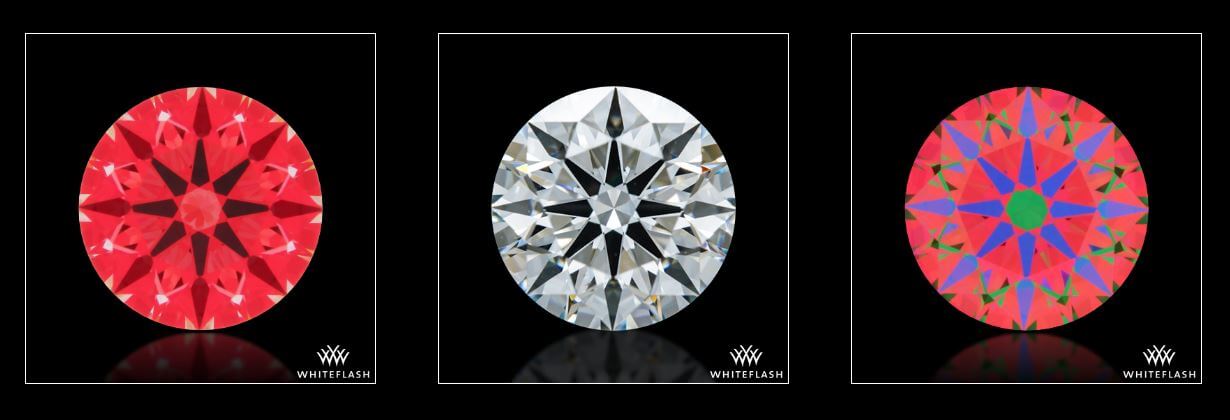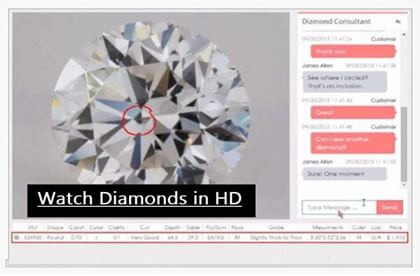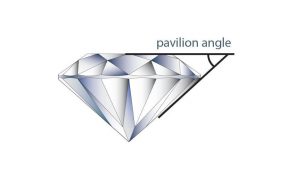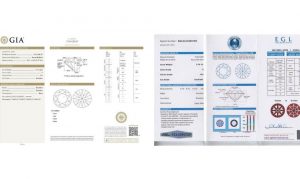The brilliance, fire and scintillation of a diamond are some of the most important attributes of a diamond. These three independently and collectively are functions of the light performance of the diamond and determines how beautiful and bright the diamond is going to turn out to be.
Diamond Brilliance
The brilliance of a diamond plays a very important role in the diamond’s beauty. There are 2 components to a diamond’s brilliance, which are brightness and contrast. A bright diamond would normally give most of the light that it gets from the surrounding back to the eye of the observer. The brightness of the diamond would reduce if the light that comes into the diamond escapes from the bottom and sides of the diamond. The more the escape, the less light there is to reflect back and the lesser the diamond’s brilliance. This light leakage is dependent on the proportions of particular diamond attributes, which are the pavilion angle, crown angle and the culet.
The pavilion angle and the crown angle is usually cut in a way that they complement each other. If the pavilion angle is too deep, the crown angle would be shallow and vice versa, in order to complement themselves. This will ensure that there is a balance between the brilliance and fire of the diamond and most of the light that enters into the diamond is reflected and not lost. If the crown angle of the diamond is shallow, it would lead to the diamond exhibiting more brilliance at the expense of the diamond’s fire. The depth (or shallowness) of a diamond affects how much light the diamond reflects. When a diamond is either too dep or too shallow, it is unable to reflect light back to the observer. Hence, the diamond is usually dull and lacking in brilliance.
The culet of the diamond plays the biggest role in determining how much light is used by the diamond and how much is allowed to escape. The culet grade ranges from None – Very large. The best culet grade is “None” because it does not give space for light to escape through the bottom of the diamond. The “Very large” grade is the most inappropriate for diamonds because the very large hole under the diamond is enough space for the majority of the light that comes into the diamond to leave. So the culet of a diamond directly determines how much brilliance the diamond exudes.
The contrast of a diamond, which is the second component of the diamond’s brilliance, is closely related to the scintillation of the diamond. The contrast of a diamond leads to scintillation in the diamond. When a diamond with a high contrast is moved, it usually scintillates and this makes the diamond appear brighter. An example of how scintillation caused by contrast aids brightness (or brilliance) is the chess board. There are 2 common causes of contrast in diamonds. One of those is leakage. It is ironic but small leakage can enhance contrast. Those little leakage areas commonly found on a diamond’s girdle (on the left) can help add some contrast to the diamond and make it scintillate while in motion. The second thing is the head and body of the observer. This is a completely external factor. But the obstruction of light by the head and body of the observer can lead to contrasting star (found on the right side) due to the opaque nature of the observer’s head.
Diamond Fire
The fire of a diamond is the light dispersed from the diamond that appears as flashes of colors. This is another component of a diamond’s beauty. A diamond’s fire is also determined by the diamond’s crown angle. A shallow crown angle usually leads to less fire from the diamond but a steeper crown angle will give the diamond more fire at the expense of the diamond’s brilliance, especially if it is combined with a small diamond table.
A diamond with a steeper crown angle invariably means that the crown facets are larger and the crown is higher. This characteristic means that the diamond will receive more incident rays and these rays are dispersed better by the higher crown (which acts as a prism) and the diamond therefore exhibits more fire.
Standard assessments have discovered that diamonds with steep crown angles only tends to disperse light away from the observer. This implies that, it is possible for you to not see the fire that the diamond exhibits but when other people look at the diamond from a different angle, they will notice that it exhibits a lot of fire.
Although the combination of small diamond tables and steep crown angles usually produce more fire, they also produce less diamond brilliance. The less brilliant the diamond is, the more fire it shows. Less fire is also noticed in more brilliant diamond. This is normal as the bright light from the diamond covers the fire from the diamond, making the diamond’s fire less noticeable.
Diamond Scintillation
A diamond scintillation refers to the sparkles seen in the diamond as you move the diamond. Scintillation in diamond is the alternation of black and white sparkles on the diamond during the movement of the diamond from one point to another. This alternating black and white scintillation can be seen well in an environment of office lighting or other environments where it is possible for fire to be absent totally. Scintillation can also be enhanced by spot light fire or under pin point. It is also normal for diamonds to have many beautiful flashes spread across the face of the diamond. The scintillation in a diamond is closely related to the level of contrast in the diamond. Diamond with more contrast will show more scintillation and will invariably shine brighter than diamonds without contrast.
A diamond with high scintillation will have some very few points on its surface that will dull and lacking sparkle. While most of the diamond surface emit very visible sparkle, these dull parts creates the contrast and brings out the scintillation in the diamond. As you move, the sparkling parts of the diamond surface and the dull parts alternate to create the scintillation and make the diamond appear brighter. As you move the chess board with alternating white and black spots on the surface, it scintillates and creates an illusion that makes it appear brighter than a plain white paper you are holding in hand and moving with.
Ideally, every brilliant diamond should have a balanced scintillation. There should be some facets on the diamond that appears dark and other facets that sparkle, in order to create scintillation. The diamond cutter must however be careful to balance this. If there are too many dark facets, the diamond will appear too dark. If there are too many sparkling facets, the diamond will lack scintillation.
How Diamond Cut Affects the Brilliance, Fire and Scintillation of Diamonds
The cut of the diamond is regarded as the most important component of the diamond (most important of the 4Cs). It affects the physical appearance of the diamond the most and of course determines the light performance and beauty of the diamond.
Every unrefined diamond has all their brilliance, fire and scintillation that they need to be beautiful and attractive locked up in them. It is therefore the job of a good diamond cutter to cut the diamond in the best possible way to ensure that the brilliance, fire and scintillation in the diamond is maximized, for the diamond to come out brilliant and beautiful.
When a diamond is therefore cut to ideal proportions, that is, it has an excellent cut grade, the diamond will be able to reflect and bend light in such a way that it is able to maximize the brilliance and fire of the diamond. But on the other hand, the farther away the diamond is cut from these ideal proportions, the less fire and brilliance the diamond exhibits.
If a diamond cutter cuts a diamond too deep or too shallow in comparison with the ideal proportions, light will be able to escape from different parts (especially the bottom) of the diamond. This means that the reflection of light (which leads to the diamond’s brilliance) and the dispersion of light (which leads to the diamond’s fire) are affected. There is less light left for the diamond to disperse and reflect back to the observer’s eye.
The GIA (gemological institute of America) has a scale with which they grade the cut of a diamond. The scale runs from “Excellent cut” to “Poor cut”. The brilliance and fire in diamonds vary through this scale. Diamonds with the most brilliance and fire are graded as “Excellent” while those with the worst are graded “Poor”. If you want a brilliant and fiery diamond, you should always look through the cut grade of the diamond and settle for either the excellent cut or the very good cut. The good diamond cut is pretty much average. Whatever you do, do not settle for either of the fair cut or poor cut. They can be as dull as an ordinary rock.
How Clarity Affects the Brilliance and Fire of Diamonds
The facets of a diamond has to be cut to mathematical proportions to disperse the light that a diamond receives into a multi colored light which we see and call the fire of the diamond. But there is another important factor that affects the amount of fire that a diamond shows. It is the clarity of the diamond.
The clarity of the diamond is a measure of the amount of impurity or flaw that is found in the diamond or on the surface of the diamond. The GIA grades the clarity of a diamond on a scale from Flawless – Included. This scale is based on the presence of impurities in the diamond, the location of the impurity, the size of the impurity, and the number of impurities in the diamond.
The more inclusions are present in a diamond, the higher the possibility of the diamond lacking in fire and sparkle. This is because, based on the number and sizes of the inclusions in the diamond, they are capable of restricting or blocking the free movement of light in the diamond. So there are less light being reflected and dispersed by the facts of the diamond. This is why a diamond with a large number of inclusions or diamonds that are low on the clarity scale, do not usually appear bright and beautiful but appear rather dull.
If the flaws are just impurities on the surface of the diamond, they will also affect the brilliance of the diamond, although not as much as the inclusions in the diamond would. The inclusions will prevent the free flow of light in the diamond and reduce the light that is dispersed and reflected by the diamond but the surface impurities (not inside the diamond) does not have the power to do that. They affect the brilliance and fire of the diamond by blocking its shine.
After the facets of the diamond have dispersed and reflected light back towards the observer, the impurities on the surface of the diamond block the light from coming out. It is more like when you out on a lamp and you place your hand on the surface of the bulb. The bigger the block, the less light comes out and the smaller the block, the more light that comes out. So if the impurities on the surface of the diamond are numerous, then more light will be blocked from coming out of the diamond. Thereby disturbing the brilliance and fire that we expect to see from the diamond.
This is another reason to stay away from diamonds with low clarity grades. Apart from the fact that they have visible flaws inside them and on their surface, which is not pleasing to the eye, they also reduce the sparkle (brilliance and fire) of the diamond. Making the diamond appear duller than they actually are or should be.
Executive Summary
The brilliance, fire and scintillation of a diamond are 3 of the most important attributes of a diamond cut. They individually and collectively determine the overall beauty of a diamond.
Every unrefined diamond has all their brilliance, fire and scintillation that they need to be beautiful and attractive locked up in them. It is therefore the job of a good diamond cutter to cut the diamond in the best possible way to ensure that the brilliance, fire and scintillation in the diamond is maximized, for the diamond to come out brilliant and beautiful.
Brilliance: a diamond’s brilliance is how much light the diamond can reflect back to the eye of its observer. Light leakage strongly affects the diamond’s brilliance because there is less light for the diamond facets to reflect. Diamond brilliance is determined by diamond attributes like crown angle, pavilion angle and the culet. The culet determines the amount of light that is leaked through the bottom of the diamond. The larger the hole at the culet, the more light is lost, the less the diamond brilliance and vice versa. The depth of a diamond also affects its brilliance. A diamond that is too deep or too shallow is not able to properly reflect light.
Fire: this is flashes of colors seen in a diamond when the light entering the diamond is dispersed by the diamond crown which acts as a prism. Diamonds with steeper crown angles (especially when combined with small tables) usually exhibit a lot of fire.
Scintillation: This is the alternation of black and white sparkles in diamonds as you move the diamond from one place to another. Scintillation in diamond is more noticeable in places or environment where the fire in the diamond cannot be seen. The level of contrast in a diamond determines how much scintillation the diamond will have. To create scintillation, some facets of the diamond must appear dark while the other facets are bright.




